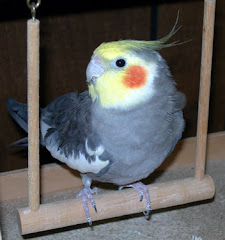Occasionally birds like to pretend they're in charge. Sometimes, this means aggression in the form of a bite or even a full-on attack, flying at you with beak open.
Frequently, this has to do with time of year and hormone levels, along with defense of territory (which can include people they have claimed), and one can watch out for warning signs and body language if you are paying attention. But assuming all other factors which can cause aggression have been addressed (bird is not sick or laying eggs, food and water are good, cage is clean, etc.), There are some handy ways to deter attacks and bites.
One personal defense method is simply to find a harmless object the bird might find a bit intimidating. Whether this is a toy or some other small object that's easy to grab, I would simply produce the item and/or say an associated word, and the bird usually straightened up quick.
As an example, in my Quaker's cage were two round perches within easy reach. He was not afraid of them when they were just in his cage being perches. But if he began to show signs of aggression, I might say, "Stick!" and reach toward them, or, in a more hostile situation, would actually pull a perch out, at which time it suddenly became the most terrifying thing in the world.
This was inadvertently discovered when trying to get him to step up onto a perch, which he did not like, and developed over time.
Of course, I would never actually touch the bird with the item. You can't physically reprimand a bird, and any physical reaction can cause them serious injury. But upon seeing the item he did know we meant business, and this was often followed by a very puffy, repentant parrot who wanted to be held a lot, and had stopped the biting altogether.
We might then work on "nice touches" and positive reinforcement, simply having him touch me or an object gently with his beak rather than a bite. This behavior was praised.
Soft objects can also be good for distraction from bites. My cockatiel sometimes liked to chomp fingers rather than step up. I have used small plastic or stuffed toys by placing them against his beak so he chewed on them rather than me, and then proceeded to either move him to a different location or push my finger into his breast in order to force a step up. This has worked tremendously and prevented me a lot of pain. Towels can be quite handy as well.
It can also help to give your bird a safe "enemy." The Quaker also had a stuffed green bird toy we called his "ducky man." He became jealous of my false affection for the duck, and thus would often take his aggression out on the poor ducky man rather than us.
Naturally, you will need to find something safe that works for your bird. Some are more fearless than others, so adjustments must be made accordingly. Don't use their favorite toys, or objects you don't want them to develop a negative response against. And, again, remember to never use physical retaliation on a bird, even beak flicking, as they can easily be injured. As with all training methods, be sure that everyone in the household is familiar with the same approach.
Greetings, Bird Lovers
I've been around bird most of my life. When I was a toddler, my parents named our budgie Bert, since I couldn't yet pronounce "bird." My dad's parents had doves and lovebirds. My mom's had homing pigeons, raised budgies and even ended up with a stray attack rooster, who was practically bigger than me and didn't like me much.
In 4th grade, my grandparents let me pick my very own budgie, and I've been blessed to care for five of my own. In high school I volunteered at what is now the World Bird Sanctuary, once finding myself surrounded by baby emus. And I've more than a few times stopped traffic to rescue injured birds.
With a lifetime of bird experience, and often receiving questions on birds and bird care, I created this page to more easily share a few "wing tips" and helpful resources.
In 4th grade, my grandparents let me pick my very own budgie, and I've been blessed to care for five of my own. In high school I volunteered at what is now the World Bird Sanctuary, once finding myself surrounded by baby emus. And I've more than a few times stopped traffic to rescue injured birds.
With a lifetime of bird experience, and often receiving questions on birds and bird care, I created this page to more easily share a few "wing tips" and helpful resources.
Feel free to comment with any questions, and take good care of those feathered friends! (:}>
Wing Tips: Safe Behavior Correction
Subscribe to:
Post Comments (Atom)






No comments:
Post a Comment